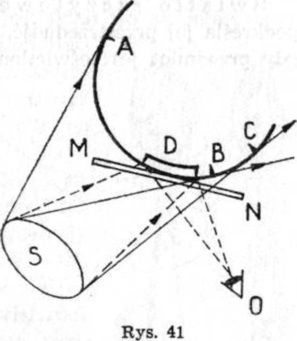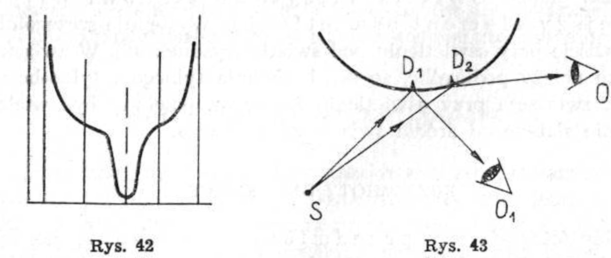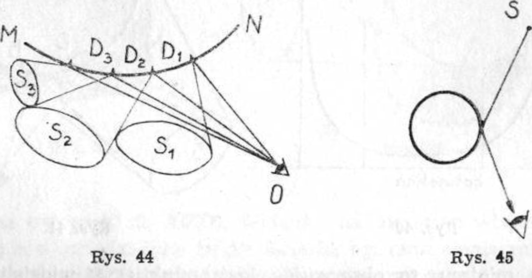The already described chiaroscuro is created on matte surfaces. Light reflected from semi-matte surfaces behaves differently. When the surface of the illuminated object is not completely dull, but semi-matte, we are dealing with the formation of the peak light phenomenon, also called brilliance. It is a consequence of the reflection of the light source from shiny surface elements (drawing 41).  Source of light (scattered) tworzy na powierzchni oświetlonego przedmiotu strefę światła (AB), penumbra (BC), and a narrow peak light zone (D). If we placed a mirror MN at point D, równoległe do powierzchni przedmiotu w tym miejscu, then observing them from point O, we would see in it a specular reflection of the light source S. Drawing 42 is a graph of the object's brightness, on whose surface the peak light was formed.
Source of light (scattered) tworzy na powierzchni oświetlonego przedmiotu strefę światła (AB), penumbra (BC), and a narrow peak light zone (D). If we placed a mirror MN at point D, równoległe do powierzchni przedmiotu w tym miejscu, then observing them from point O, we would see in it a specular reflection of the light source S. Drawing 42 is a graph of the object's brightness, on whose surface the peak light was formed.

The behavior of the peak light is different from the behavior of the light or penumbra. When the illuminator and penumbra invariably occupy the same position on the object, the peak light moves across its surface depending on the direction, from which we observe them. In the drawing 43 peak light, being a reflection of the light source S for the observer from point O1, will be seen in D1, and from point O2 — at D2.
The peak light highlights the surface, emphasizes its spaciousness. Its effect is evident, when an object is illuminated by a single light source.
 In the drawing 44 for the observer O of the light source S1, S2, S3 make the top lights in D1,D2, D3. In this way, the entire part of the MN surface is evenly illuminated, it becomes flat, non-plastic stain. The peak light is the brightest part of the lighting. It is especially visible when illuminated against the light (drawing 45). Therefore, it should be emphasized, that the rear and rear side light sources, especially under incandescent lighting, should be many times weaker than the main light source.
In the drawing 44 for the observer O of the light source S1, S2, S3 make the top lights in D1,D2, D3. In this way, the entire part of the MN surface is evenly illuminated, it becomes flat, non-plastic stain. The peak light is the brightest part of the lighting. It is especially visible when illuminated against the light (drawing 45). Therefore, it should be emphasized, that the rear and rear side light sources, especially under incandescent lighting, should be many times weaker than the main light source.